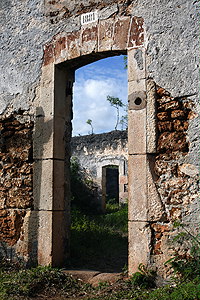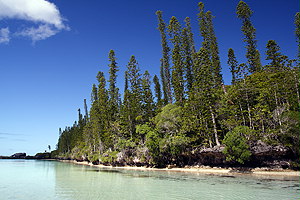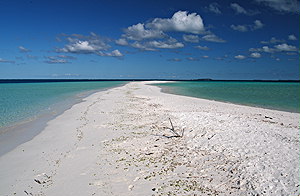Forgotten Penal Colony
The first day after my arrival I left the hotel and walked onto the seaside promenade. I felt like I already knew the place. Modern architecture was present everywhere. There were plenty of coffee shops overlooking the bay, a marina with hundreds of yachts, colorful logos of French companies, and many boutiques and supermarkets. I was surprised by the heavy traffic as well as the well-developed public transportation system.
To get here, I changed planes several times and spent many long hours in the air. My destination was a remote island, somewhere in the South Pacific. I expected a lush, exotic setting, but surprisingly I found myself in an ordinary European city, like those in the south of France. I was to say the least, a little disappointed. I asked myself, where is the legendary beauty and distinctiveness of the islands of Oceania?
Place of Exile

detained in New Caledonia
Located north of New Zealand, New Caledonia is a rapidly growing overseas territory of France. Its capital Noumea the city that expands constantly attracts an ever-increasing numbers of immigrants from Europe. It is hard to believe that just 90 years ago, life there was completely different. Shortly after 1853 when France introduced its control here, it turned out that none of Europeans were willing to settle on the islands. A penal colony was established. Its inmates had a dual purpose: serving their punishment as well as populating the islands at the same time. Till 1922 one thousand convicts, ordinary criminals and political prisoners, came to New Caledonia. A significant number of detention centers were established; most of them still standing to this day. During my stay I visited one of these prisons. I walked through a narrow entrance leading to two high walls, one after another. Inside there were free-standing houses with windows up by the ceiling. The buildings were not arranged in a grid system, but in constructed in a circle. This is because one guard standing in the center of the square was able to observe all the prisoners. In the damp, dark reaches of the prison cells the walls are worn, cracked, and covered with fungus. In fact, the convicts had nowhere to escape, even if the opportunity arose. Back then, the area around the prisons was inhabited by the indigenous population, hostile to newcomers. Fugitives knew that outside the walls certain death and suffering awaited them in the form of cannibalism practiced by the native people. French New Caledonia was also the place of exiles for many members of the Paris Commune. Most of them returned to France after serving their sentences. Some prisoners like the Pole Antoni Berezowski, participant of the Polish January Uprising against Russia, who in 1867 made an unsuccessful assassination of Tsar Alexander II of Russia in Paris, came to the colony without the right of return. He died here in 1916.
Native Islanders

When you travel outside the capital of the colony you can see that the European dominates rest of the territory, which is inhabited by the indigenous Melanesian people. The French government promotes the “Western” and commercialized consumer lifestyle, unknown to people of the Pacific. Kanaks, the native inhabitants of New Caledonia, are slowly losing their identity. I visited several local art galleries owned by the French immigrants, not the natives looking for something that would come from New Caledonia. A lot of the items, often quite old, originated from other islands like Papua New Guinea and Vanuatu, but unfortunately there were no works by local artists. Puzzled, I asked the salesman, “Why don't you sell pieces of local artists? Is no one interested in buying them? What about old sculptures and masks? After all, they should be preserved somewhere. Similarly, like the way it is in other parts of the Pacific, I thought to myself. I always received the response: “Unfortunately, nothing has survived.” After a pause, the vendor added, “These are the consequences of the rules of the first missionaries. Back then, in many villages they organized mass destructions of all symbols of the old faith and culture. Kanaks had to bring their works of art to be burned in pits of fire.”
Fortunately, local cooking traditions have survived and many small family restaurants are based on local cuisine. One of traditional local Kanak dishes is bougna. It resembles the baked potato. The name bougna literally means a bundle, or package. Actually it is a bundle of mixed taro, yam, sweet potatoes and bananas, all wrapped in palm leaves. Sometimes a chicken, fish or crab is added. All of the ingredients are tied with a string creating quite a sizable “package”. It is worth noticing that no pots are used in cooking. A “bundle” is put directly in a mound of hot stones and buried in sand. Guests are usually invited to observe how their dinner is unearthed. When I saw women working with shovels and hoes, strewing rocks and sand, I began to worry about my meal. I was certain that I will eat not only local vegetables but also plain sand. It is hard to believe, but I did not feel any grinding between my teeth. Years of practice of local cooks make wonders.
Ile of Pines

coniferous trees, occur more frequently than palms
New Caledonia houses many unique species of plants. Many of them have survived unchanged since the Mesozoic Era, the age of the dinosaurs. Equally interesting and unique is the underwater ecosystem. The coral reef of New Caledonia has a length of 1500 km/900 miles and is the second largest in the world after famous Australia's Great Barrier Reef. Among the many specimens, the largest phenomenon of the underwater world is the Nautilus, surviving for millions of years. This cephalopod with a sizable spiral shell is often referred as a “living fossil”. The best place to enjoy the beauty of the realms of land and sea is in Île des Pins, or the Isle of Pines. The name of this small island was given by Capt. James Cook, who was the first European to discover it. Apparently, he was charmed by the coast overgrown by slender conifers, not palms. For most people the symbol of an exotic paradise is a sandy beach with palm trees in the background. Ile of Pines is different. Native evergreen and tall archaic coniferous species of araucaria columnaris, occur more frequently here than palm trees. This is really extraordinary and unique. The small number of hotels is an additional benefit because it leads to a limited number of tourists. The most famous place is the so-called natural swimming pool or piscine naturelle, as known by locals. It is sort of a small lake, but with salt water, marine fish and its own tiny coral reef. This is an amazing natural wonder. Not having a permanent connection with the sea, this “pool” is surrounded on all sides by pine trees and is supplied with water from the ocean only at high tide. It is impossible to visit this place without walking across water. In the immediate vicinity, there are no cafes or restaurants, but that is of no importance. The place is beautiful by itself and that is absolutely enough.
Uninhabited Island

The New Caledonia reef is huge. It is fantastic to enjoy it while diving, but its true dimension can only be judged only from the air. Water changes shades frequently, from deep blue, to light blue, to turquoise. While flying on a plane, you can see not hundreds, but thousands of different isles and islets. Almost all are deserted. The smallest, without fauna and flora, have blue-green water in the background and look like a sandbox in a children's playground. Larger islets have various shapes. One overgrown with greenery and with a long tail of sand resembles a comet in the cosmos. Another islet brings to mind a more prosaic object. It is shaped just as the contour of a beer bottle. All of these views build an irresistible desire to explore these places. Hoping to not just feast on the aerials one would wish spend time completely alone on a deserted island, quite like Robinson Crusoe. Nowadays, you do not have to be a ship wreck survivor to have this luxury. The simplest means of achieving this other-worldly dream is to rent a boat.
One day, early in the morning, a local Kanak took me on board his boat. After a brief conversation we agreed on a price. “Nice small islet, no problem”, he said, and started the engine. We sailed just as a speedboat racer slaloming between poles, avoiding places where the reef touches the water's surface. I caught myself, once again, not believing how many different hues of the ocean there actually are. In many places the limestone along with the strong rays of the sun created a unique spectrum of optical light effects. Soon, the boat ran ashore and the local said, “I'll be back before sunset!” I stood on the beach of Nokanhui, an islet, which turned out to be just a strip of sand surrounded by shallow, calm water, resembling a lake. There were no waves, the fierce ocean roared in the vast distance. To walk around the little isle could have taken me literally only a few minutes, but I took my time and wandered slowly around its reaches for hours. Why rush? I set aside my fast-paced, metropolitan attitude and feasted in the laurels of peace and tranquility of nothing more than simple sand and endless, serene water.
In New Caledonia, I found peace, harmony and admiration in the beauty of the exotic wildlife on land and underwater. The places I visited and I appreciated the most had no crowds, no loud music and lacked the typical tourist kitsch. New Caledonia, far away from its France inspired capital, has an authentic island feeling where no one is in a hurry and each person you encounter will surely be your friend.
Text: Maciej Swulinski




